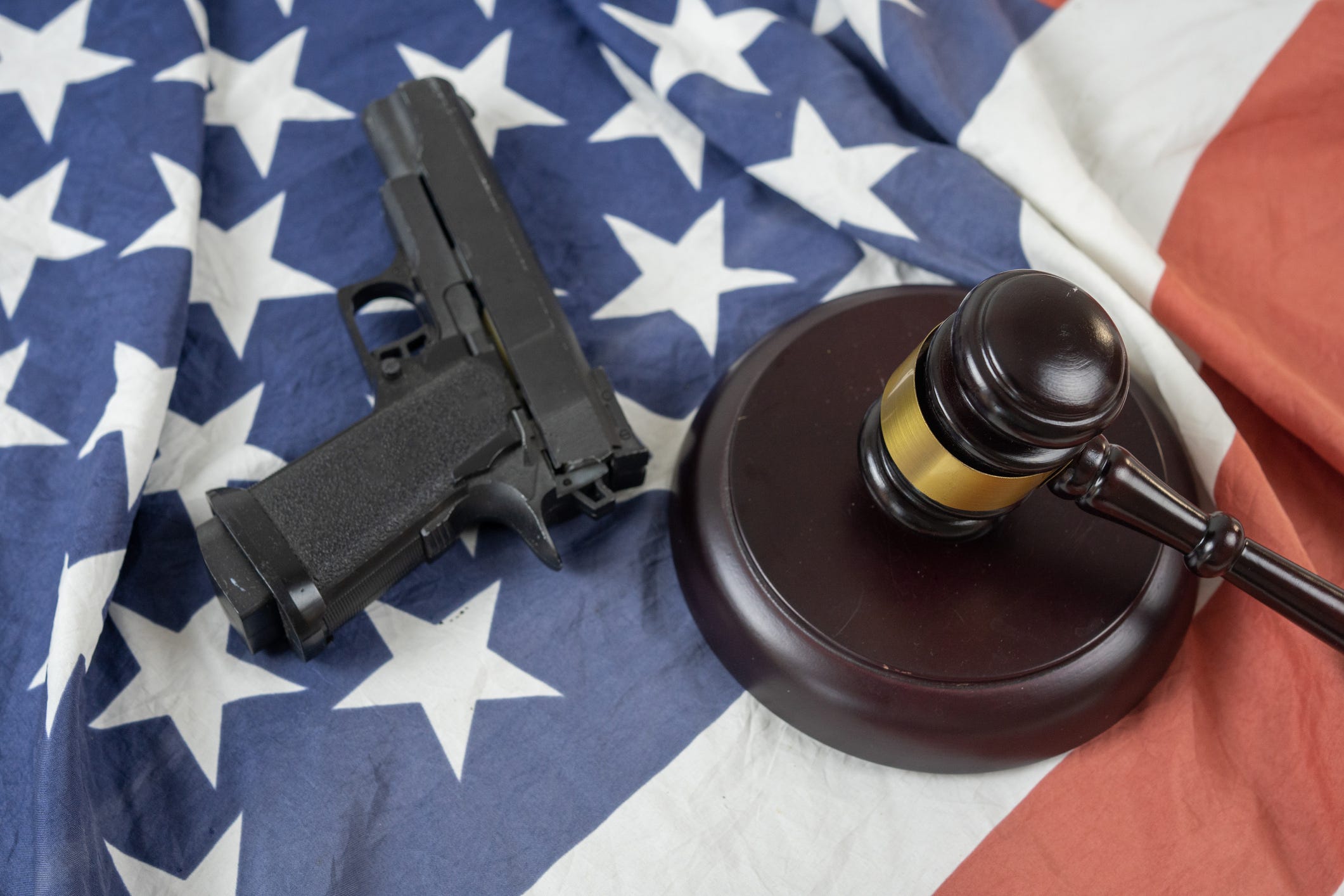|
 |
How the Supreme Court’s Big Gun Cases Played Out
The court’s decisions affecting gun rights will have both near-term and long-term effects
The Supreme Court delivered two major gun decisions this term, and while both will have significant effects on American gun policy, we should watch for those impacts to happen on different timelines.
First, the court tossed out a ban on bump stocks—a ban instituted after the 2017 mass shooting in Las Vegas, in which a lone gunman killed 60 people and injured more than 400. The gunman used weapons fitted with the special stocks, which enabled the guns to fire rounds at a more rapid pace.
In Cargill v. Garland, a 6-3 majority found the Bureau of Alcohol, Tobacco, Firearms and Explosives (ATF) exceeded its authority when reclassifying bump stocks as machine guns because they didn’t fit the definition provided in the underlying law. “In any event, Congress could have linked the definition of ‘machinegun’ to a weapon’s rate of fire, as the dissent would prefer,” Justice Clarence Thomas wrote for the majority. “But, it instead enacted a statute that turns on whether a weapon can fire more than one shot ‘automatically ... by a single function of the trigger.’ And, ‘it is never our job to rewrite ... statutory text under the banner of speculation about what Congress might have done.’”
Certainly, the outcome is a rebuke of former President Donald Trump since he ordered the ATF to reclassify the devices in the wake of their use in the Las Vegas shooting, and he’s stood by that decision even after lower courts began to question its legality. But it also represents a setback for President Joe Biden (and a boon to gun-rights activists) because many of the current administration’s gun restrictions are based on the same rulemaking process. They also share many of the same pitfalls the court focused on in Cargill.
For instance, one sticking point the high court had with the bump stock ban was the way the ATF had flip-flopped on the devices after years of telling the public they were merely unregulated stocks—not illegal unregistered machine guns. “For many years, the [ATF] took the position that semiautomatic rifles equipped with bump stocks were not machineguns under the statute. On more than 10 separate occasions over several administrations, ATF consistently concluded that rifles equipped with bump stocks cannot ‘automatically’ fire more than one shot ‘by a single function of the trigger,’” Thomas wrote. “In April 2017, for example, ATF explained that a rifle equipped with a bump stock does not ‘operat[e] automatically’ because ‘forward pressure must be applied with the support hand to the forward handguard.’ And, because the shooter slides the rifle forward in the stock ‘to fire each shot, each succeeding shot fir[es] with a single trigger function.’”
Biden’s subsequent bans on pistol braces and “ghost gun” kits were also implemented unilaterally through ATF rulemaking, stretching the limits of current federal law. Both involved the agency revisiting years or even decades of guidance. And both have struggled in federal court challenges, with multiple judges blocking their enforcement under similar reasoning adopted by the Supreme Court in Cargill.
The Cargill decision could have a similar effect on Biden’s rule expanding who needs to obtain a federal license to sell used firearms. It, too, has faced lawsuits advancing the same claims, which have also seen some early success in the lower courts. However, unlike the other ATF rules, it coincides with a change in the underlying federal law that could provide some support for a reinterpretation—though not all authors of the updated law agree.
It’s clear, then, that Cargill is likely to upend many of the gun restrictions the Biden administration has managed to implement in the near-to-mid term. But it’s unlikely to have a long-term impact on the scope of protected gun rights. That’s because the bump stock ban challenge and its follow-ons don’t deal with the Second Amendment.
U.S. v. Rahimi, on the other hand, does. In an 8-1 ruling, the court delivered just its sixth opinion on the scope of the Second Amendment. It upheld the gun ban for anyone subject to a domestic violence restraining order, but only on a narrow basis.
“In Heller, McDonald, and Bruen, this Court did not ‘undertake an exhaustive historical analysis ... of the full scope of the Second Amendment,’” Chief Justice Roberts wrote for the court. “Nor do we do so today. Rather, we conclude only this: An individual found by a court to pose a credible threat to the physical safety of another may be temporarily disarmed consistent with the Second Amendment.” The ruling was narrow enough that the Department of Justice immediately asked the court to take up a slew of other cases to further clarify federal gun laws.
But the narrow scope of the core holding doesn’t mean the case won’t have major implications for every Second Amendment challenge across the country moving forward. That’s because Rahimi is the first time the court itself has applied the Second Amendment test it set up in 2022’s New York State Rifle and Pistol Association v. Bruen. The way the court went about upholding the charges against Rahimi will influence lower courts far more than the finding that his charges comport with the Second Amendment.
The Bruen test requires the government to justify modern gun restrictions by showing they are within the historical tradition of regulations that date to the time when the Second Amendment was ratified. While the court was nearly unanimous in its finding that the government did just that in Rahimi, the single dissenter happened to be the very man who authored the test just two years ago. Justice Clarence Thomas strongly disagreed with the majority’s conclusion.
“After New York State Rifle & Pistol Assn., Inc. v. Bruen, this Court’s directive was clear: A firearm regulation that falls within the Second Amendment’s plain text is unconstitutional unless it is consistent with the Nation’s historical tradition of firearm regulation,” Thomas wrote. “Not a single historical regulation justifies the statute at issue.”
He warned the majority’s method of examining the historical record could effectively invalidate the Bruen test and even the Second Amendment itself. “Given that imprisonment (which involved disarmament) existed at the founding, the Government can always satisfy this newly minted comparable-burden requirement,” Thomas wrote. “That means the Government need only find a historical law with a comparable justification to validate modern disarmament regimes. As a result, historical laws fining certain behavior could justify completely disarming a person for the same behavior. That is the exact sort of ‘regulatory blank check’ that Bruen warns against and the American people ratified the Second Amendment to preclude.”
The rest of the court disagreed, arguing the domestic violence restraining order gun ban is similar enough to a pair of Founding-era laws to pass muster. “The dissent reaches a contrary conclusion, primarily on the ground that the historical analogues for Section 922(g)(8) are not sufficiently similar to place that provision in our historical tradition,” Chief Justice Roberts wrote. “The dissent does, however, acknowledge that Section 922(g)(8) is within that tradition when it comes to the ‘why’ of the appropriate inquiry. The objection is to the ‘how.’ For the reasons we have set forth, however, we conclude that Section 922(g)(8) satisfies that part of the inquiry as well.”
But the debate over how best to apply Bruen, and the majority coming down on a looser approach than Thomas, is sure to influence how judges approach every other Second Amendment case for years and years to come.
That effect is compounded by the Supreme Court’s most recent action on gun cases. While the court has already agreed to hear Vanderstok v. Garland and decide the legality of Biden’s “ghost gun” kit ban, it declined to hear any of the Second Amendment challenges seeking certiorari. The longer the court waits to take more Second Amendment cases, the longer Rahimi remains the only guide for implementing the Bruen test—and the more important the court’s most recent decision becomes.
That all means we should expect to see the impact of Cargill on a much shorter timeline than that of Rahimi. However, Rahimi may end up more influential on gun policy in America over the long run.
You’re currently a free subscriber to Discourse .

